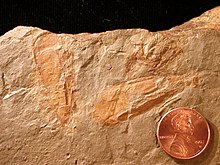Hyolitha
| Hyolitha Temporal range: Fortunian to end Permian,
| |
|---|---|

| |
| Hyolithes cerops, Spence Shale, Idaho (Middle Cambrian) | |
| Scientific classification | |
| Domain: | Eukaryota |
| Kingdom: | Animalia |
| Phylum: | Brachiopoda |
| Class: | †Hyolitha Marek, 1963 |
| Orders | |
Hyoliths are
Morphology
The shell of a hyolith is typically one to four centimeters in length, triangular or elliptical in cross section. Some species have rings or stripes. It comprises two parts: the main conical shell (previously referred to as a ‘conch’) and a cap-like operculum. Some also had two curved supports known as helens[4] They are calcareous – probably aragonitic[7] All of these structures grew by marginal accretion.
Shell microstructure
The orthothecid shell has an internal layer with a microstructure of transverse bundles, and an external layer comprising longitudinal bundles.[7]
Helens
Some hyoliths had helens, long structures that taper as they coil gently in a logarithmic spiral in a ventral direction.[7][4] The helens had an organic-rich central core surrounded by concentric laminae of calcite. They grew by the addition of new material at their base, on the cavity side, leaving growth lines.[7]
They were originally described by Walcott as separate fossils under the genus name Helenia, (Walcott's wife was named Helena and his daughter Helen); Bruce Runnegar adopted the name helen when they were recognized as part of the hyolith organism.[7] Encrusting organisms have been found on helens, and also on both sides of the main shell, all of which are therefore supposed to have been raised above the sea bed. The helens have been interpreted as props that supported the feeding organ, the lophophore, above the sea bed.[4]
Operculum
The operculum closes over the aperture of the shell, leaving (in hyolithids) two gaps through which the helens can protrude.[7] It comprises two parts: the cardinal shield, a flat region at the top of the shell; and the conical shield, the bottom part, which is more conical.[7] The inside of the shell[the inside of the operculum?] bears a number of protrusions, notably the dorsal cardinal processes and the radially-arranged clavicles.[7]

Soft tissues
The soft tissues of the mid-Cambrian hyolith Haplophrentis, from the
Taxonomy

The hyoliths are divided into two orders, the Hyolithida and the Orthothecida.
Hyolitha have dorso-ventrally differentiated opercula, with the ventral surface of the shell extending forwards to form a shelf termed the ligula.[7]
The Orthothecida are somewhat more problematic, and probably contain a number of non-hyoliths simply because they are so difficult to identify with confidence, especially if their operculum is absent.[7] They have a straight (planar) opening, sometimes with a notch on the bottom side, and sealed with an operculum that has no ligula, clavicles, furrow or rooflets.[9]
Hyptiotheca is an unusual hyolithid, in that it lacks clavicles.[9]
Orthothecids fall into two groups: one, the orthothecida sensu stricto,[10] is kidney or heart shaped in cross-section due to a longitudinal groove on its ventral surface, and its opercula bear cardinal processes; the other has a rounded cross-section and often lacks cardinal processes, making them difficult to distinguish from other cornet-shaped calcareous organisms.[9] All were sessile and benthic; some may have been filter feeders.[10]
Phylogenetic position

Because hyoliths are extinct and do not obviously resemble any
A secure classification at last became possible in 2017, on the basis of
A study in 2019 estimated that hyoliths are more likely to be basal members of the lophotrochozoans rather than lophophorates.[5] Meanwhile, a study in 2020 instead concluded that hyoliths belong to Mollusca,[14] as did a different study in 2022.[6]
Ecology
Hyolithids were benthic (bottom-dwellers), using their helens as stilts to hold the opening of their shells above the sea floor.[4] Orthothecids did not have helens, but are presumed to have been sessile and benthic.
In the Cambrian, their global distribution shows no sign of provinciality, suggesting a long-lived planktonic larval life stage (reflected by their protoconchs); but by the Ordovician distinct assemblages were becoming evident.[9]
Some orthothecids are preserved in vertical [life] orientation, suggesting a sessile suspension-feeding habit; hyolithids tend to be flat on the bottom, and their shape and the occurrence of epibionts are consistent with a sessile suspension feeding habit via orientation relative to passive currents.[15]
Occurrence
The first hyolith fossils appeared about 540 million years ago in the Purella antiqua Zone of the
Similar organisms
Due to the simple shape of their shell, hyoliths have been something of a wastebasket taxon, and organisms originally interpreted as hyoliths have sometimes later been recognized as something else – as for example in the case of the cnidarian-like Glossolites[17] and Palaeoconotuba.[18]
See also
References
- .
- ^ .
- ^ .
- ^ (PDF) from the original on 9 October 2022.
- ^ PMID 34692060.
- ^ S2CID 251866827. Retrieved 25 November 2022.
- ^ .
- . Retrieved 26 November 2022.
- ^ a b c d Malinky, J.M.; Skovsted, C.B. (2004). "Hyoliths and small shelly fossils from the Lower Cambrian of North−East Greenland". Acta Palaeontologica Polonica. 49 (4): 551–578.
- ^ S2CID 130227630.
- JSTOR 29739075.
- ^ .
- S2CID 140660142.
- PMID 32811320.
- ISBN 978-0231505161.
- .
- S2CID 255125977.
- S2CID 256562444.
